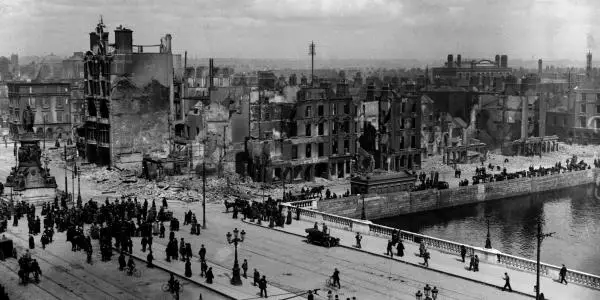An extraordinary trove of rarely-seen photographs lays bare the utter carnage wreaked on Dublin during the tumultuous Easter Rising 100 years ago this weekend.
Drawn from the Press Association archives, scenes comparable to modern-day war zones show great swathes of O’Connell Street and Eden Quay entirely obliterated.
The capital’s streetscapes are instantly recognisable yet disfigured and decimated, mostly by British artillery fire.
Crumbling facades are all that stand from once proud buildings lining the bustling, world-famous thoroughfares.
A bird’s-eye view of the General Post Office, the rebel headquarters, taken from Nelson’s Pillar in the aftermath of the bombardment shows it to be a mere shell.
The monument which stood on the site of its present-day replacement The Spire survived the devastation all around it in 1916, but was blown up by republicans in 1966 to mark the 50th anniversary of the insurrection.
Despite the destruction, the Press Association archive photographs also capture people going about their normal lives in the days following one of the most momentous events in Irish history.
People are seen gathering on street corners to talk about the horror, perhaps the surrender or execution of the Rising leaders, next to makeshift wood and barbed wire barricades manned by British troops.
Hundreds more dressed in suits and bowler hats, dresses and bonnets, are walking the city’s streets as usual, maybe on their way to work or the shops, against a backdrop of ruination – the scene of almost 500 deaths, most of them civilians.
There are touching portraits too.
Two beaming girls, one with a baby tucked into her sling-fashioned shawl, look delighted with themselves, having salvaged wood from bombed-out buildings that will heat their families for a night.
In another photograph, capped youngsters and older men scour the rubble on the streets for souvenirs of the rebellion.
Worried savers gather outside the Dublin Savings Bank which is shut with a sign placed outside declaring: “WILL OPEN WHEN LAW AND ORDER IS FULLY RESTORED”.
One image shows a man peering in disbelief as he ventures into the burnt out husk of the once grand Royal Hibernian Academy picture gallery on Abbey Street.
British soldiers are also seen guarding an improvised armoured car made from a locomotive boiler.
It was used to move troops from point to point during the Rising and both fake and real loopholes can be seen on the side of the boiler – a security measure of the day.
